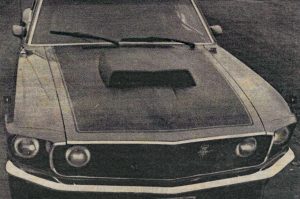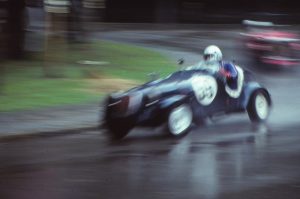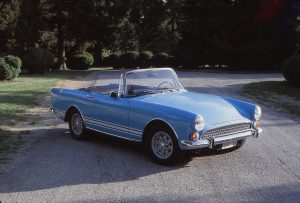Originally published in AutoWeek on February 27, 1984.
Wayne Conover bought the car for parts. As the proprietor of Conover’s Cobra Ranch, a restoration shop specializing in Shelby automobiles, he was always on the lookout for Shelby performance pieces, and the ‘66 notch back Mustang was a gold mine.
Disguised, maybe, by a hideous black paint job and a high-school drag-racer jacked-up-in-the-rear stance, it was a motherlode of parts. The engine was full Shelby, complete with a remote oil filter and oil cooler. The dash had a full complement of Shelby gauges, and in the trunk was a genuine fuel-cell.
If anything, it was too good for just a street racer, so when Conover got the Mustang back to his Hanover, Pennsylvania, shop, he decided to investigate the car’s past.
He started with the doors, carefully sanding off layers of paint: suspicions confirmed. A number disks on the door revealed the car had indeed been a racer. But whose?
His curiosity now severely tweaked, he called a friend in the Shelby club who provided one special clue: a photo from AutoWeek & Competition Press, circa 1966. Could it be Tom Yeager’s 1966 Trans-Am Mustang? Everything was in the right place, even the quick jack brackets under the front valence panel.
An initial phone call to Yeager himself seem to stir little interest on the Ohio end of the line, so Conover removed a few specific pieces, including the driver’s door, to cart them out for Yeager’s personal inspection. That did it. Yeager quickly identified the parts of the car he raced, and pointed out work he had done himself.
Now, any old racecar is interesting, but Yeager’s Mustang was something else. Yeager, who had started racing in 1960 in a Lotus 7, switched to a Merlin and then a Shelby GT 350 in B Production in 1965. Finishing second in the SCCA’s Central Division to fellow Ohioan Bob Johnson that year, Yeager decided to enter the SCCA’s new Trans-American sedan championship, and since it was to be a series of enduros, he would team up with his former nemesis and commandeered Johnson’s mechanic, Tom Greatorex, as well.
Yeager secured partial sponsorship from Kennedy Ford of Columbus and selected a metallic blue notch back Mustang off the lot as the racer designate. Fastbacks were, of course, available, but only the notch was considered a sedan by the SCCA. Greatorex prepped the Mustang, and except for the body style it could easily be mistaken for just another GT350 with its Shelby-bedecked motor.
To modern eyes, grown accustomed to tube-chassis funny cars riding mere millimeters above the pavement, the Yeager Mustang is incredibly naïve. Ride height appears barely altered from stock, and chassis reinforcement is limited to a couple of well-placed rollbar struts and a stress bar linking the inner fenders. The SCCA had intended it to be a showroom of touring cars, therefore modifications were limited. In fact, stock carpeting was required until Bob Johnson announced to the stewards that he would be racing the next race without that fire hazard and what-were-they-going-to-do-about-it.
Another requirement was a working handbrake, but with the four-wheel disc set up, the Mustang was left with no easy solution. Other, that is, then a bit of skulduggery: The stock parking brake handle was attached to the foot pedal to at least give the appearance of a separate system. Whatever gets you through tech, right?
Anyway, Greatorex did not have the Mustang ready for the inaugural four-hour event at Sebring, won by Jochen Rindt in an Alfa GTA with Bob Tullius taking big car honors and second overall in his Dodge Dart. First time out, however, Yeager came in first, besting Tullius at the Cumberland National. Another National at Grayling, and it was another first. At the National at Mid-Ohio Yeager finished first in class.
Then came the Mid-America 300, is the second race on the Trans-Am circuit. Johnson and Yeager led all but the pitstops to give the Mustang a win in his first professional race. Another National, this Road America’s June Sprints, and yet another first gave Yeager Central Region championship.
The Mustang, having taking a first in each of its first five races, came in fourth overall at the Bryar 500, though taking second in class. Johnson and Yeager were back to their winning ways at the VIR 400 at Danville, Virginia, but it would be the last victory for the pair in the Mustang. At the Marlboro 12-hour they finished ninth, although still managing to pick up points for fifth in class.
Then the money ran out.
The sturdy little Mustang’s career was not quite over, however. The Central Division championship earned Yeager another trip to Riverside for the runoffs. But success eluded him in this last 1966 race. A holed piston in a specially prepared sprint engine sidelined the Mustang while lying third.
Under Yeager’s tutelage the Mustang would make one more outing, a masochist’s delight consisting of the 1967 Trans-Am opener, a 300 miler at Daytona on Friday, Feb. 3, followed by the Daytona 24 hours starting at 3 p.m. the next day. This engine with which Walt Hane, a personal friend of Yeager, had won B Production honors at Riverside would be used for the Trans-Am, and an endurance engine and different rear axle would be fitted overnight for the 24 hour event. It would be difficult, but it could be done.
And they almost pulls it off. Hane led easily for the first 73 laps of the 80 lap Trans-Am, but then the engine blew. Someone had installed the wrong spark plugs.
The 24-hour race went a little better, though the beleaguered Mustang was literally falling apart through the race. Glue sealed an oil leak, a broken left rear axle was repaired in the infield, a rear end swap resulted from four hours of running with different diameter tires on either side of the rear. And for most of the race both front fenders were secured primarily by tape.
Yeager and Hane finished a distant second in class, 16th overall – the highest placed Ford – and the beneficiary of propitious DNF’s. The real shock, though, came in post-race inspection: The crankshaft came out of the engine in two pieces. It had broken across the center main bearing, apparently early in the race when a sudden 10-pound drop in oil pressure had been noted, but by keying had stayed together for the duration.
Tentative plans to run the much rougher Sebring were scrubbed, and the Mustang was carted back to Ohio and sold. Raced in amateur events, the last Yeager had heard of the car was it is it been stuffed into a tree.
At least until Conover appeared in Yeager’s driveway asking, “Is this your door?”
There was no doubt, at least to Conover and Yeager, that this was Yeager’s old racer. But a later visit by Conover frosted the cake. Yeager presented Conover with a set of black and white photographs: Detail shots of the interior of the car, of the trunk and under the hood.
The photos facilitated an accurate rebuilding of the Mustang. Other lucky finds, such as obsolete Goodyear and Kelsey-Hayes decals and a spare fuel pump bracket prepared for the racer back in 1966 and gathering dust ever since, made the reborn Mustang yet more accurate.
But the photos provided the ultimate key. By holding one of them upside down the serial number can clearly be read, and it matches those on the car. This Mustang is the real thing. The only way for it to be more real would be for it to be June 12, 18 years ago just outside of Wentzville, Mo. Bob Johnson perspires in his Nomex, waiting for the LeMans-type foot race that will start the Mid-America 300…
Spare parts indeed!



















What Do You Think?
You must be logged in to post a comment.